
© Stas Levshin, courtesy the Mikhailovsky Ballet. (Click image for larger version)
Mikhailovsky Ballet
The Flames of Paris
St. Petersburg, Mikhailovsky Theatre,
22, 23 July 2013
www.mikhailovsky.ru
How do you like your balletic revolutions? After decades of confining The Flames of Paris to the history books, the ballet world now has two productions to choose from: Alexei Ratmansky’s for the Bolshoi, which makes its London debut this month, and Mikhail Messerer’s brand-new reconstruction for the Mikhailovsky Ballet. They could hardly be more different, and how you rank them partly comes down to what you expect from an evening at the ballet: a straightforward, conventionally classical romp of a piece or a neoclassical retelling striving for greater psychological depth.
Messerer’s new production is certainly much closer to Vasily Vainonen’s 1932 work. By all accounts, more than 75 per cent of the choreography was traced back to the original through various means, including Messerer’s own recollection of the ballet, in which he danced as a child, and the memories of dancers from that era. Whether some of these sources can be relied upon is another matter, but we are unlikely ever to see a more complete reconstruction of The Flames of Paris, and Messerer’s production is far more than a historical curiosity.
Ideology may matter less than in Vainonen’s time, but here, too, Messerer is at odds with Ratmansky. While the latter is clearly ambivalent about the effects of the revolution, Messerer has unabashedly trotted out the flags and the revolutionary chants. It’s an odd stance for this French viewer: even the Bolshoi’s production was greeted with some circumspection on tour in Paris, as the local audience tends to recoil at the sight of both overt patriotism and overly literal works. You’ll see more flag-waving and blue, white and red in this St. Petersburg production than on any French stage; in that sense, The Flames of Paris says much more about Russia than it does about France (it’s no coincidence that it is said to have been Stalin’s favorite ballet), but Messerer runs away with the zany verve of it all.
He achieves this by taking Flames at face value. Don’t expect any form of irony here: the aristocrats are an evil lot who turn over poor men’s carts and kill actors on a whim; the good-hearted crowd is united once and for all, and upon winning, throws a lavish divertissement composed of dance allegories of Liberty, Fraternity and Equality. The result is a simple, sure setting for the Soviet-flavoured high jinks Vainonen devised in the 1920s.
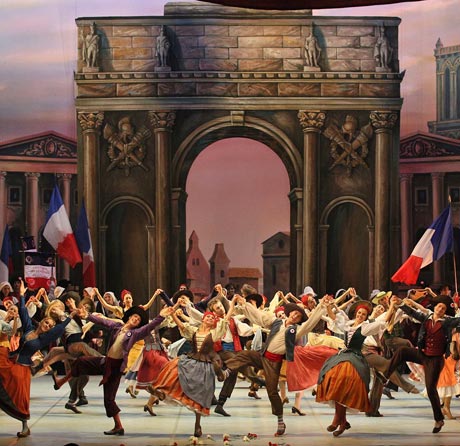
© Stas Levshin, courtesy the Mikhailovsky Ballet. (Click image for larger/full version)
And as is often the case with careful reconstructions, Messerer has restored the ballet’s original logic. With three short acts instead of Ratmansky’s two, the ballet is paced to perfection, and leaves us wanting more every time the curtain comes down. The sets and costumes are self-explanatory; at no point are we in doubt about the storyline. (The use of video to provide interludes between scenes, including a fuzzy filmed invasion of the Tuileries by a virtual crowd, is the only dubious choice, at odds with an otherwise decidedly traditional production.)
There is a lack of egotism to Messerer’s work that is immensely appealing, too: unlike Nureyev or Grigorovitch, he never appears to be coercing the music or the steps into fitting his idiosyncratic vision. The quarter of the choreography that can be attributed to him is near-impossible to pick apart, and in his hands ballet is a vital force, all bright and uncluttered steps. The Flames of Paris should easily become one of the Mikhailovsky’s greatest successes, and the troupe was visibly energized by it, with excellent, committed performances from all involved, a stark contrast to the Mariinsky’s demeanour on stage streets away in St. Petersburg.
If there is a hero in Messerer’s Flames, it’s the crowd. Jeanne and Philippe barely dance a step until Act II, and their relationship is a done deal from the moment they meet; the actress Diana Mireille, a rather more important character than in the Ratmansky version (where she’s known as Mireille de Poitiers), serves to move the plot along, and is transformed into an allegory of Freedom in Act III. The corps, meanwhile, does much more than cheer from the sides. Its march forward to the tune of revolutionary song Ca ira is an expression of its gathering strength and comes midway through the ballet, whereas Ratmansky includes it at the very end of his version and contrasts it with the human cost of the revolution. Messerer also introduces different groups, some of them identified by their native region, as they would have been historically (Basques, Auvergnats in clogs, Marseillais), and restores the ballet’s character numbers to their former glory.
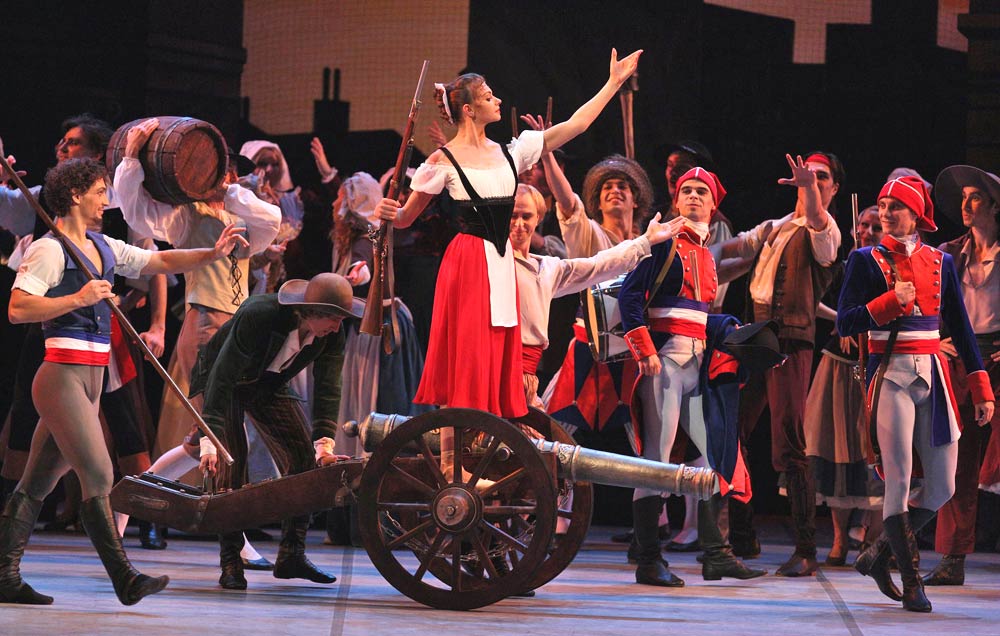
© Stas Levshin, courtesy the Mikhailovsky Ballet. (Click image for larger version)
The famous Basque dance, in particular, has been returned to its rightful owners: character dancers. Ratmansky’s decision to hand it over to Jeanne, Philippe and their friends deprived the Bolshoi’s character luminaries from their chance to shine (Yuliana Malkhasyants!), and while Osipova or Alexandrova have the projection to attempt it, its effect often seemed only a fraction of what we saw on the Mikhailovsky stage. Opening-night honours went to Mariam Ugrekhelidze, a 2009 Vaganova graduate and young character specialist, and hers was a darkly intense performance as Basque leader Theresa.
The other story of the first two performances was Angelina Vorontsova, the pupil of Nikolai Tsiskaridze who has made headlines this year for her relationship with Pavel Dmitrichenko and her complex history with Sergei Filin. It wasn’t that long ago, however, that she was touted as a potential Bolshoi star after a convincing gold medal at the 2009 Moscow International Competition. Her Bolshoi days are now behind her, but the Mikhailovsky has lost no time in signing her up and offered her a principal position, no less, the morning after her first performance.
Her turns as Diana Mireille on opening night and Jeanne the next day showed just why. The blonde Vorontsova makes a genuinely sweet heroine, and the Bolshoi has clearly shaped her effortless, organic technique for the better: the bravura turns and jumps required of Jeanne were performed with sunny ease and sparkling musicality. As Mireille, a role she also performed with the Bolshoi, her smooth-as-silk pointe work in the arduous Act I variation was a thing of beauty, and she flew through the Freedom pas de deux in Act III, a marathon of death-defying lifts in the best Soviet tradition (props go to Marat Shemiunov as the strongman). The Mikhailovsky repertoire is now hers to explore, and her career will be one to follow.

© Stas Levshin, courtesy the Mikhailovsky Ballet. (Click image for larger version)
On the men’s side, Ivan Vasiliev raised the stakes in virtuosity on opening night. There is clearly no crowd in tights he can’t lead to a revolution: his feverish expression and envelope-pushing tricks are an apt dance substitute for revolutionary speeches. As Philippe, his repertoire included triple sauts de basque, triple tours en l’air, and all manner of outrageous, hair-rising jumps. He knows they are, too, and it’s half the fun in this riot of a ballet: before his Act III variation, he strutted to the corner with all the time in the world, the image of seductive confidence, stopping just short of running his hand through his hair.
Oksana Bondareva, Vasiliev’s partner on opening night and a gold medal winner at last month’s Moscow Competition, had her own bag of tricks as Jeanne, including 16 fouettés with leg à la seconde (tours à la seconde on pointe, if you will!), but presented them with rather less charm; her manner is still a little forceful, and it shows in her upper body, despite natural stage presence. Ivan Zaytsev, the second-cast Philippe, made a game attempt at the bravura choreography, and brought youthful energy to the table alongside Vorontsova.
Another standout was Viktor Lebedev, whom some may remember as the top male graduate of the Vaganova Academy’s 2010 class. Like Olga Smirnova in 2011, he chose to start his career elsewhere, and the Mariinsky can harbour some regrets: Lebedev is all classical elegance, a true prince on stage, and was faultless both as Antoine Mistral and in the Fraternity duo the next night. Indeed, that tricky duo, which he performed with Andrei Yakhnyuk, was as impeccable as you’d expect the Raymonda male pas de quatre to be in more prestigious companies: a clear sign that the Mikhailovsky’s stock is rising.










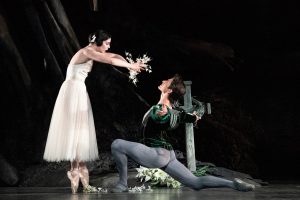
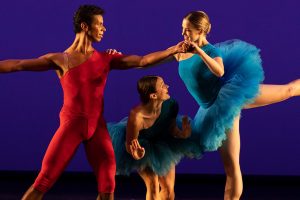
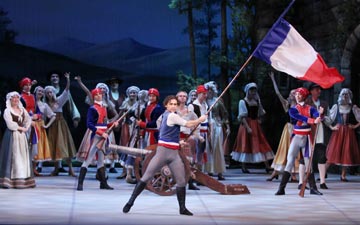
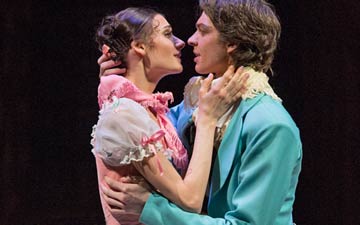
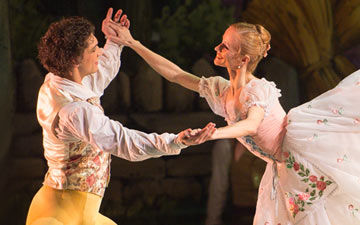

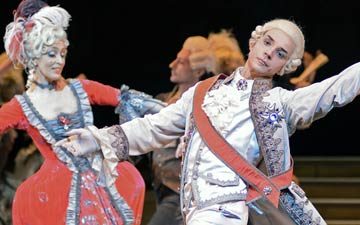
This review certainly whets one’s appetite for an alternative view of ‘Flame’. Can we expect to see it when/if the Company visits London next time? And any news of when that might be?